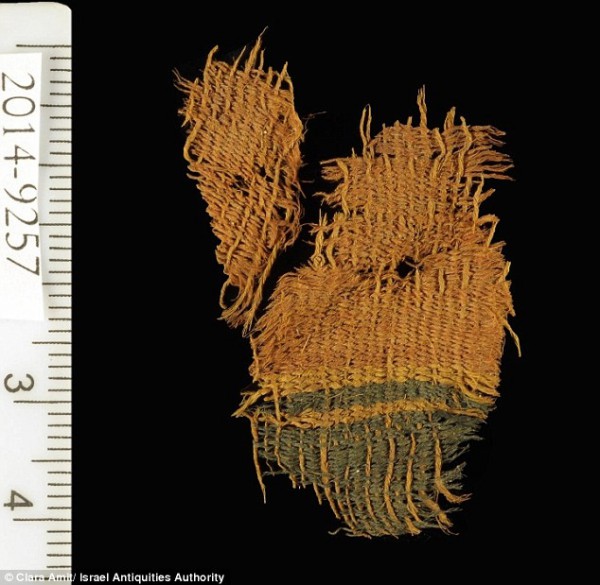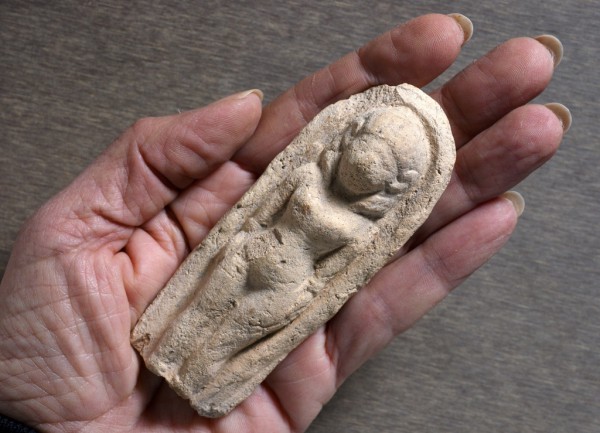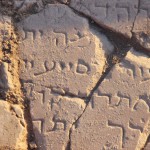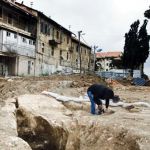“Iron is taken from the earth, and copper is smelted from ore. Mortals put an end to the darkness; they search out the farthest recesses for ore in the blackest darkness.” (Job 28:2–3)
In Israel, expert archaeologists and children alike can unearth the Holy Land’s history. This past week, a 7-year-old discovered a 3,400-year-old artifact while a professional team uncovered millennia-old fabrics.
Ori (Uri) Grinhot, age 7, earned a certificate of appreciation for good citizenship from the Israel Antiquities Authority (IAA) after sharing his find of a female figurine at the Tel Rehov archaeological mound this past week.
While walking with friends at Rehov, Ori “came across a stone that had shifted and suddenly saw an image of a person covered with soil. Ori rubbed away the mud that adhered to the object and thus discovered the clay figurine,” the IAA reported.
Tel Rehov expedition director, Amihai Mazar, noted that the figurine would have “belonged to one of the residents of the city of Rehov, which was then ruled by the central government of the Egyptian pharaohs.”
“Ori returned home with the impressive figurine and the excitement was great,” said his mother, Moriah Grinhot, to IAA. “We explained to him this is an ancient artifact and that archaeological finds belong to the State.”
Grinhot lives in the Tel Te’omim communal settlement in the Bet She’an Valley, a 1.5 km walk north from Rehov, which offers a rich archaeological footprint with an intermixed Israelite-Canaanite history that once numbered 2,000 residents.
Mazar, who is also professor emeritus at Hebrew University, said on the IAA website that the statuette “is typical of the Canaanite culture of the 15th–13th centuries BCE.”
“Some researchers think the figure depicted here is that of a real flesh and blood woman, and others view her as the fertility goddess Astarte, known from Canaanite sources and from the Bible,” Mazar told the IAA.
IAA officials presented Grinhot his award at Shaked Elementary School in Kibbutz Sde Eliyahu, at the time that Ori’s teacher Esther Ledell was leading a Torah lesson.
“It was an amazing occasion! The archaeologists entered the class … just when we were learning about Rachel stealing her father’s household gods, “Ledell told IAA. “I explained that the household gods were statues that were used in idol worship, and all of a sudden I realize that these very same idols are here in the classroom!”
In the past, archaeologists at Rehov have discovered 30 intact beehives from the mid-10th to early 9th century B.C. — the oldest known evidence of an ancient beekeeping industry — and proof for the timeline of the Kingdom of Israel, with Rehov’s city layers linked to Iron Age II, the Early Bronze Age, the Late Bronze Age, and Medieval Times.
Meanwhile, in the Arava Valley, about halfway between Eilat and Be’er Sheva, a team from Tel Aviv University announced this past Wednesday that they have found fabrics dating to King David’s rule over Israel.
TAU’s Dr. Erez Ben-Yosef led his team into the Timna copper mines where they discovered the 3,000-year-old textiles that demonstrate the weaving techniques and fabric design of the ancient inhabitants.
According to TAU affiliates, most of the fabric found at Timna was made of sheep’s wool, “a cloth that is seldom found in this ancient period,” while linen, a cloth that was not made locally, was also found.

Pieces of fabric found at Solomon’s mine show differences in color, weaving, and ornamentation techniques. (IAA photo by Clara Amit)
“This tells us how developed and sophisticated both their textile craft and trade networks must have been,” said TAU master’s student Vanessa Workman to the Jerusalem Post. “The fabrics are of a very high quality, with complex designs and beautiful dyes.”
“The arid condition of the mines has seen the remarkable preservation of 3,000-year-old organic materials, including seeds, leather and fabric, and other extremely rare artifacts that provide a unique window into the culture and practices of this period,” TAU said in a statement.
The IAA reported the fabrics are about 5 by 5 cm in size, varying by color, weave and style, with some similar to “textiles known only from the Roman era” and some “worn by the upper echelon” of the early Edomite society. Workman also stated that the quality of the fabric “strengthens our understanding of the Edomites as an important geopolitical presence.”
“We found fragments of textiles that originated from bags, clothing, tents, ropes and cords,” said Dr. Orit Shamir of the IAA to Jerusalem Post, also describing them as being connected to the semi-nomadic Edomites that are thought to have operated the Timna mines.
“Luxury-grade fabric adorned the highly skilled, highly respected craftsmen managing the copper furnaces. They were responsible for smelting the copper, which was a very complicated process,” Shamir said.
Ben-Yosef added that “the act of smelting, of turning stone into metal, required an enormous amount of skill and organization. The smelter had to manage some 30 to 40 variables in order to produce the coveted copper ingots.”
“If a person had the exceptional knowledge to create copper, he was considered well-versed in an extremely sophisticated technology. He would have been considered magical or supernatural, and his social status would have reflected this,” he added.








